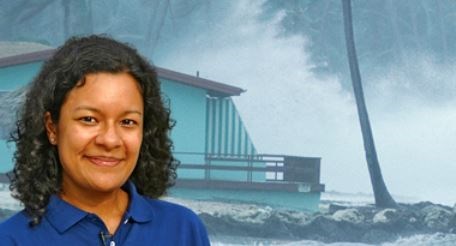 |
| (photo credit: JASON project) |
Most people hear about an impending hurricane and do their best to either protect their home and ride it out inside, or find a way to get out of its path as quickly as possible.
Shirley Murillo, on the other hand, hops on a plane and heads right towards the eye.
You might call her a risk taker. She’ll tell you, though, that it’s all in the name of science, and really, all in a day’s work.
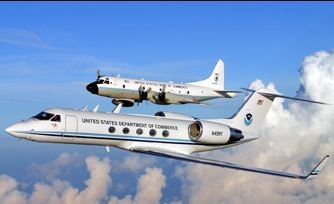 |
| U.S. hurricane hunter aircraft scan the skies over the Gulf of Mexico. (Photo courtesy NOAA) |
In one 8 hour flight through winds ranging from 74 to 155 mph, Shirley and the flight crew collect a variety of data sets on the storm, including information on wind speed, wind direction (which way it's heading), location, pressure, temperature, and where the eye is located. It lets them know what the storm is doing, whether its path is changing, and whether it’s getting weaker or stronger. The information they collect is then transmitted to the National Hurricane Center and other NOAA agencies that use it for storm tracking and predictions.
She says that hurricanes are a lot like people -- ever-evolving, with their own characteristics. Flying into hurricanes helps them see the 'true character' of a storm, as often they look very different from the outside in, than they do from the inside, out.
Shirley Murillo takes the risk she does to help save lives, by helping hurricane forecasters put out early warnings to the public.
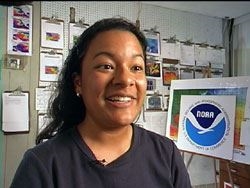 |
| Photo courtesy of The American Meteorological Society's Board on Women and Minorities (http://www.amsbwm.org/index.html) |
She is a meteorologist with the Hurricane Research Division at the National Oceanic and Atmospheric Administration (NOAA) in Miami, Florida. A meteorologist is a weather scientist, and Shirley’s focus is hurricanes and the study of the winds inside them. Using data from aircraft and satellites that monitor hurricanes, she is able to generate maps of the wind patterns and provide her information to forecasters.
For the record, Shirley isn't ALL about chasing hurricanes. She also enjoys outdoor activities, like camping, hiking, rollerblading, and running with her two dogs (she also has a black cat and two macaw parrots). Yet it is clear that hurricanes are her passion, and studying them is something she evidently excels at.
In fact, in her 20s, she is considered the top female meteorologist in the world. But her field is one dominated by males, with only 10% of meteorologists worldwide being female. Actually, in the Hurricane Research Division at NOAA she is the only Hispanic woman meteorologist. As it did in college, though, the unbalanced ratio only serves to encourage her to work even harder to excel in her field.
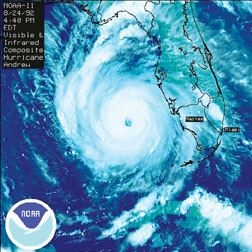 |
| Hurricane Andrew churns in the Gulf of Mexico on August 24, 1992, hours after ravaging the southern tip of Florida where it caused most of its $26 billion in total damage. |
Being a minority woman in a male dominated field is just a new hurdle to jump – Shirley’s been breaking down barriers for as long as she can remember.
For starters, she is the first in her family to graduate from college. Her parents are both from Ecuador, where Shirley was born, and did their best to help her in school, despite English being their second language. She says that in elementary school she was often chided by teachers for being too shy, and in middle school she wasn’t the best student. She admits that many people didn’t think she would get a college degree, much less one in a field of science. Obviously she proved them wrong.
Today she finds the time to visit schools, particularly in underrepresented areas, to encourage girls to get involved in science. She hopes that the love for science will find them at a young age, as it did for her. Shirley attended a ‘magnet’ high school, focused on science. As a senior she was given the opportunity to intern at the Hurricane Research Division, where she fell in love with the field of meteorology and decided to pursue it. In fact, she liked the work there so much that it’s where she currently works now.
Shirley also served as a research scientist with the JASON project, for the ‘Monster Storms’ expedition.
In many ways, the JASON Project is similar to her internship experiences. Like a true science internship, JASON affords student ‘Argonauts’ the opportunity to work hands-on with a leading scientist, immersing them in the scientific experience, and helping students find a passion for science even greater than what they had going into it.
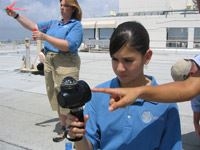 |
| Student Argonaut Cassandra Santamaria (photo credit: JASON project) |
She also likes that the JASON project teaches the importance of collaboration. Scientists don't work by themselves; they collaborate with other scientists, researchers, and even interns, as integral players working towards the same goal.
Through JASON, the student Argonauts were able to work hands-on with Cindy and see what a meteorologist does. Said 'Monster Storms' Argonaut Cassandra Santamaria of Shirley in her JASON project bio: “I was very impatient to meet her after reading her biography from the JASON curriculum. She is a research meteorologist and she is the top female hurricane researcher in the world! She was truly amazing. She makes you realize that meteorology isn’t just a man’s career; the number of women getting involved in meteorology is rapidly increasing. And she was very nice. You could tell by the way she talked about weather and hurricanes that she really loves meteorology. You can see that she is fascinated by flying in hurricane planes, using Doppler radar, receiving hurricane and weather information from all of the hurricane research tools, working with other scientists, and watching hurricanes at landfall. She also explained how the Doppler radar works, why you have to wear flight suits, and what it feels like to be in a flight suit for more than nine hours!”
Shirley Murillo touches lives, both in the girls she encourages to pursue science, and in those whose lives she saves through her work.
Page created on 9/8/2011 4:18:35 PM
Last edited 9/8/2011 4:18:35 PM
